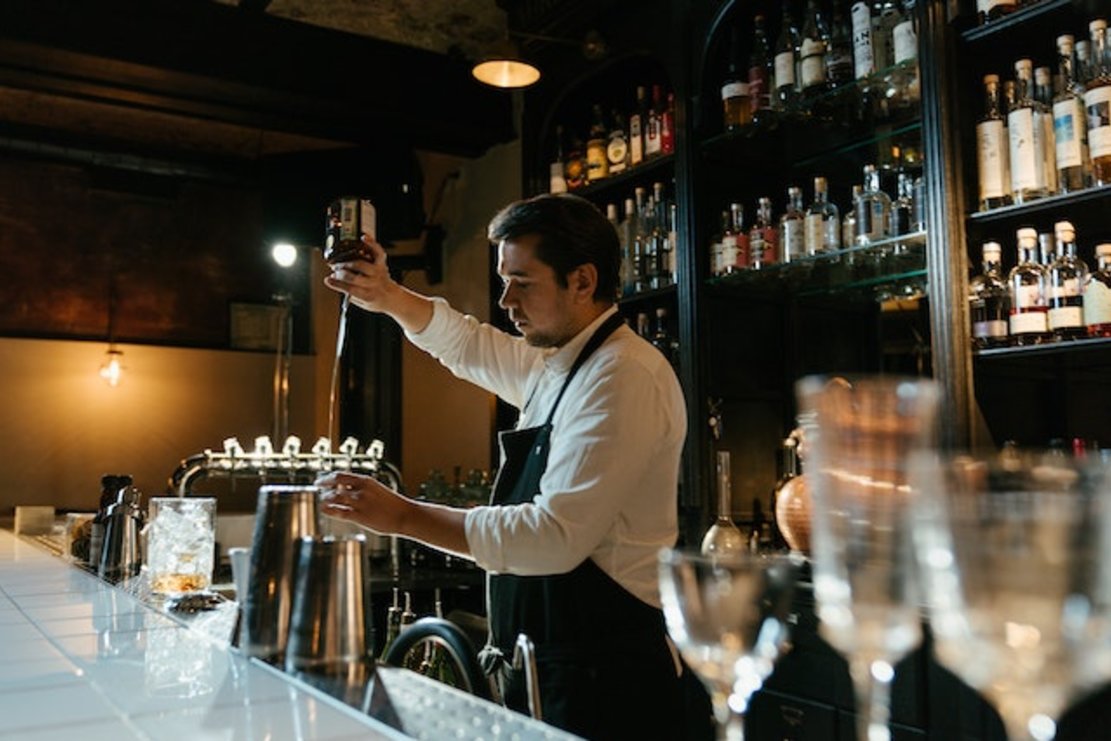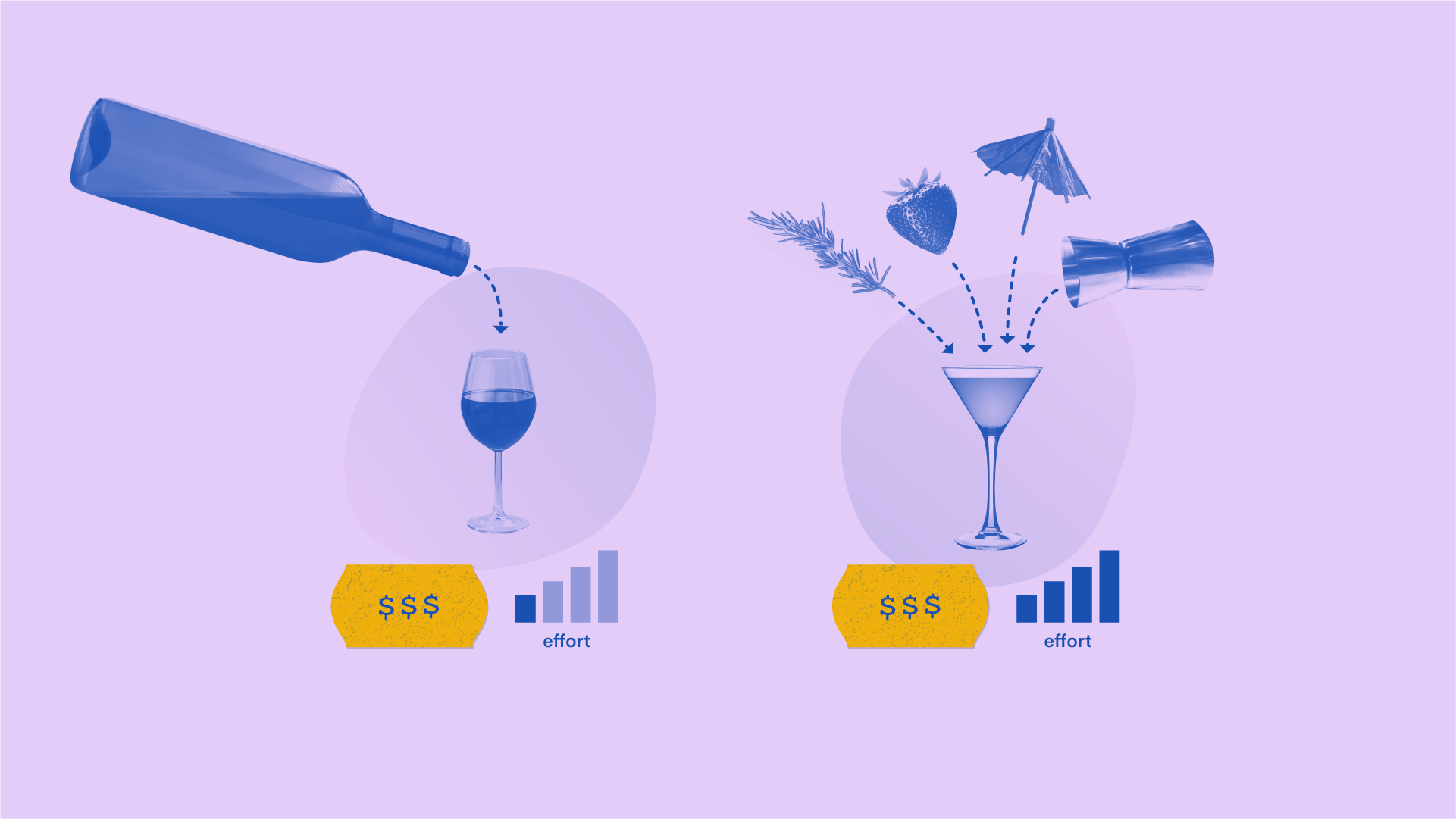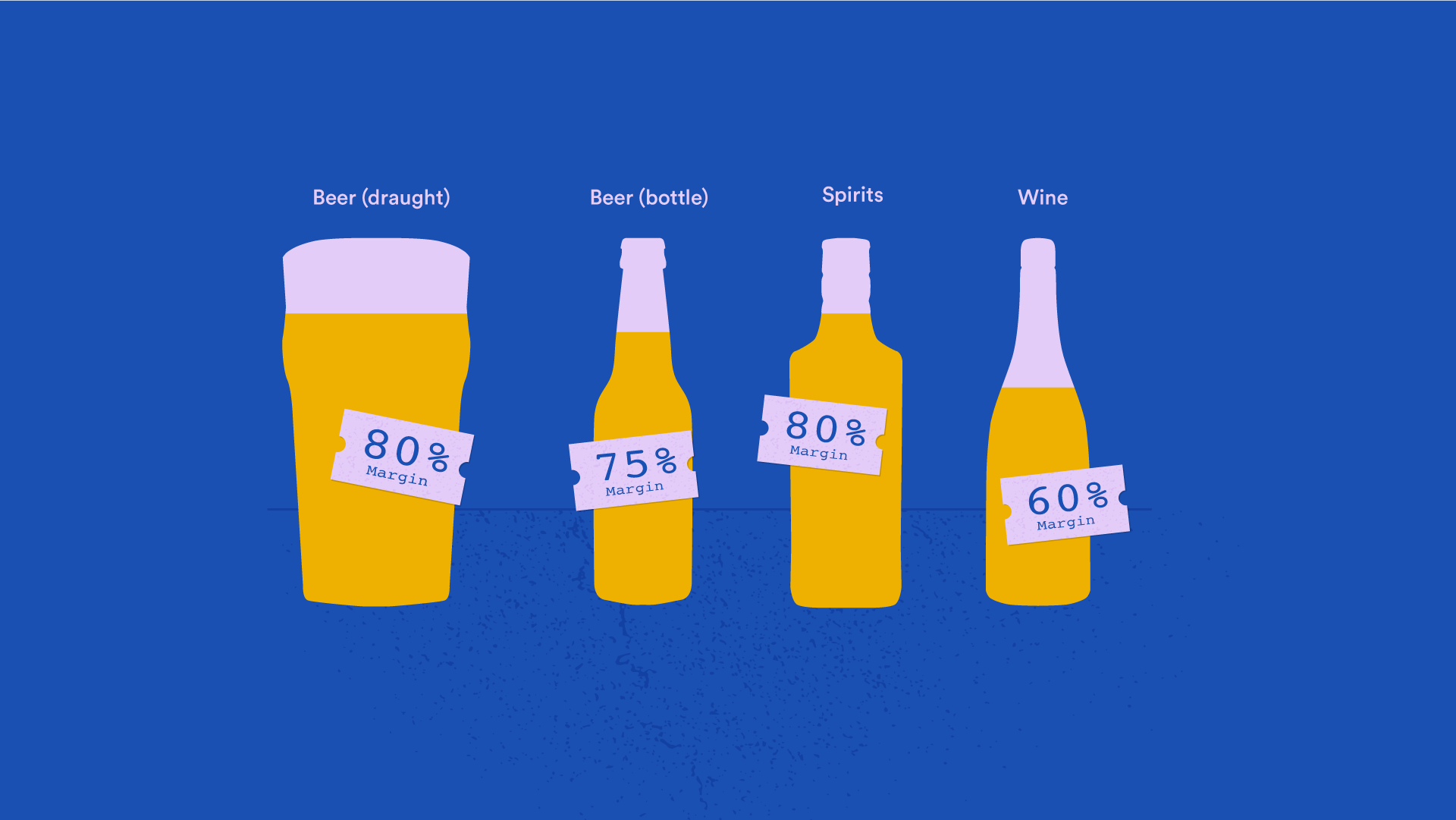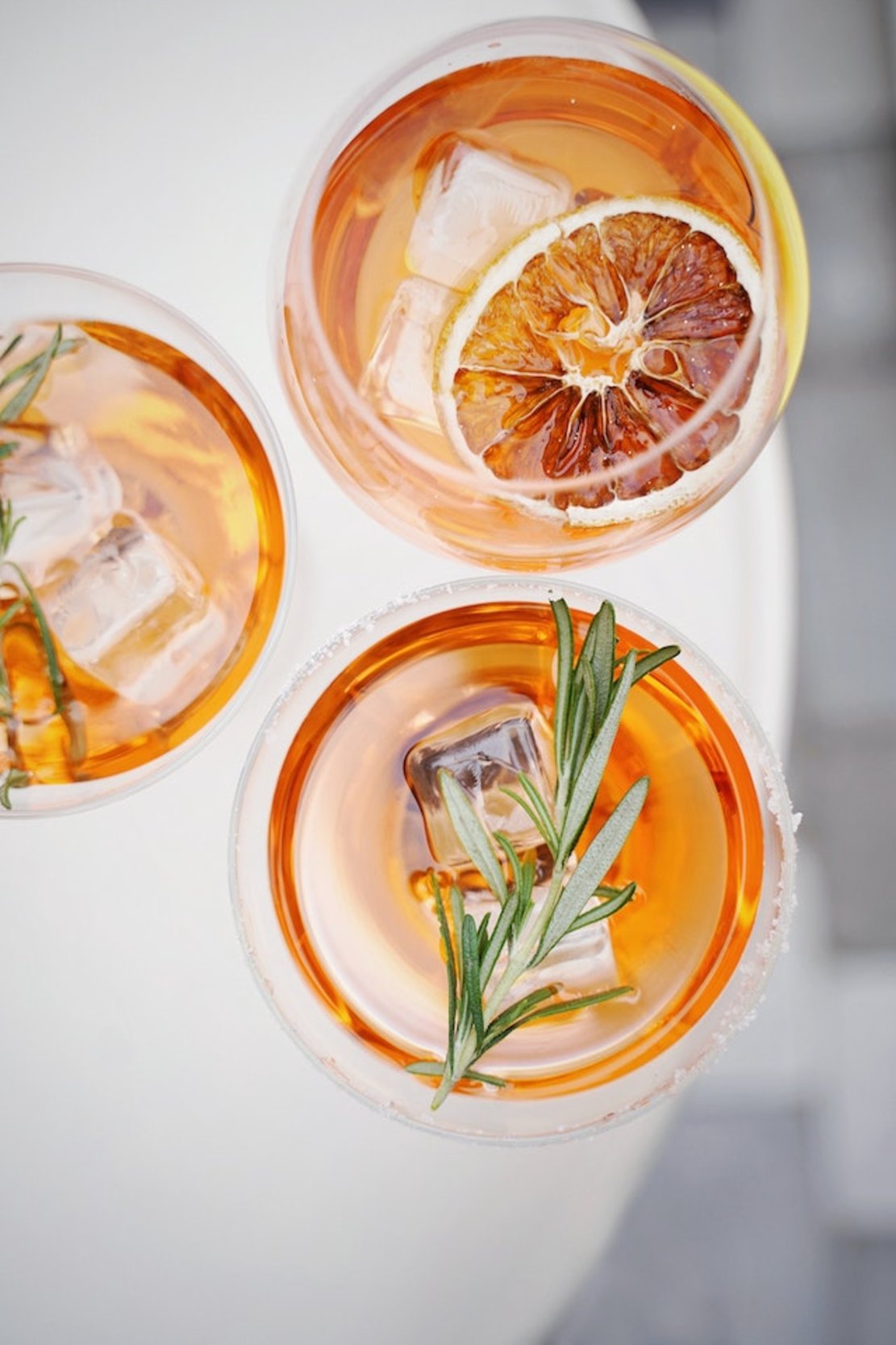The best way to have a profitable bar or restaurant is to serve drinks. Alcohol sales usually have the largest profit margins in the restaurant industry. That’s why knowing how to price liquor for a bar is so important.
It might not be the most glamorous part of the job, but it’s essential to the health of your business. Learn how to set drink prices correctly, and you’ll not only up your liquor sales and shore up your finances. You’ll also win over customers with fair menu pricing.
To start, keep reading our guide to all things beverage costs. We’ll walk you through the best pricing strategy for your beverage program, including helpful averages and formulas.

How To Price Liquor for a Bar: Start With COGS
No matter what part of your restaurant budget you’re working on, the best place to start is with COGS.
That goes with determining your average profit margin or how much to spend on commercial kitchen equipment. So it should be no surprise that this same calculation also comes up for liquor cost.
What is COGS, you ask? It stands for “costs of goods sold.” The phrase refers to how much it costs your business to produce a product. In the case of creating drinks, it is the cost of all the ingredients that go into making beverages. It goes like this:
(Opening inventory + Purchases) - Ending inventory = COGS
Let’s see this formula in action.
Say you had an opening alcohol inventory (on-hand or sitting inventory) of $2,000 at the start of the month. For the month, you purchased $6,000 in liquor stock. By the end of the month, you made $20,000 in liquor sales and had $1,000 in ending inventory liquor stock.
So to find out your COGS, aka your product usage, you’d add $2,000 and $6,000. Then, you’d subtract the $1,000 ending inventory. That would look like this:
($2,000 + $6,000) - $1,000 = __$7,000__
Therefore, $7,000 is your COGS for how to price liquor for a bar. If you subtract that amount from your total liquor sales, you’ll have your profit margin. (Aka, how much money you’re actually making on selling drinks.) In this case, your profit is $13,000.
You can also figure out what percentage COGS takes up of your sales. In this case, it’s about 35%.
Now that you know this figure, you can make sure you’re turning a profit on every drink sold.

How To Price Liquor for a Bar: Why COGS Matters
For every dollar in sales, around 35 cents goes towards paying for liquor. That means you’ve identified a gross margin of 65 cents.
This is important because it takes much less to earn that on liquor items than on food items. That means you must invest significantly less labor to make and deliver each drink than food.
Wine is an excellent example of where this can be very valuable. For instance, it’s not unusual to see a 4x markup on bottles of wine, but that’s low compared to spirits. However, you’ll easily see the profitability considering how easy it is to pour wine versus craft a cocktail.

How To Price Liquor for a Bar with Gross Profit Margins
If we stick with the wine theory, we discover why gross profit is vital in pricing liquor. For instance, the drink price of a bottle of wine is generally higher than the beverage cost of other drinks. So while the gross margin might be lower, the gross profit will be higher.
Imagine if you sell ten unique cocktails for $10 each, and they contain a margin of 80% each. The gross profit in that instance would be $80 (10 x $10 x 80%).
But if you sell a bottle for $160 at a margin of 50%, you’ll enjoy the same gross profit. The difference is the waiter took just a minute to serve the wine versus the five-minute preparation for the cocktail.
Consider this question when figuring out how to price liquor for a bar:
What would you rather sell more of? Those cocktails or a shedload of those wine bottles?
We have a basic grasp of liquor cost and profitability. Now, let’s consider how to price the most common types of liquor in most restaurants and bars.
How To Price Liquor for a Bar: Average Liquor Costs and Pour Costs
What’s pour cost? It’s just another word for liquor cost. However, it’s the more common term used in bars.
The average pour costs and pour cost percentage for bars range from 18% to 24%.
That means their pour cost is 18% to 24% of their gross sales. They want to make a gross profit margin of about 82% to 76% on their drink prices.
Next, we’ll use this information to price drinks.
You’ve got your liquor cost formula. Now let’s get into the other equation all bar owners should know: the pricing liquor formula. (Also known as the drink price formula.)
This equation varies depending on your desired profit margin, local prices, and target pour cost. But the basic outline is:
Ingredient Cost ($) / Target Pour Cost (%) = Drink Price ($)
This is the best way to price drinks by industry standards.
So let’s say you want to sell Manhattans at your establishment. You’ve looked at the average pour cost statistics and decided to shoot for a pour cost of 20%. It’s not so low that you have an off-putting markup on your cocktail menu pricing. At the same time, it’s not so high that you’re losing money.
You know that the ingredient cost for your Manhattan is $3, so you divide that by 20%:
3 / .20 = $15
There you have it: your menu drink price should be $15.

How to Price Alcohol in a Bar: Pricing Wine
Let’s get into the nitty-gritty of how to price liquor in a bar. First up: pricing wine.
This is liquor pricing at its most varied. Why? Because of the various markups on wine bottles and the different glass pours.
Here are the two most common rules for how to price alcohol in a bar: wine edition.
Wine By-the-Glass Pours
Try serving drinks at a variety of price points. The price of wine by the glass is increasing. You need to consider the cost of throwing away a bottle if no one orders another glass that shift.
Remember, people are more likely to buy two glasses of $10 wine than they are a second that costs $15. (Especially if they can easily buy that same wine at a grocery store at wholesale price.)
Wine Bottles
Industry standards for marking up bottles of wine are usually around 2.5x to 3x the price charged by the wholesaler. Head back to the gross profit section above for more on this!
Adding a good selection of premium and economy wines to your menu is also essential. That way, you have something for every price point.

Pricing beer
Next, it’s time to learn how to price beer.
Thankfully, beer isn’t expensive and can offer some decent margins - up to 80% for draft beer.
Bottled beers usually have an average gross profit margin of about 75%. However, they don’t have the same options for drinks specials as draft beers. Bottled beer is less likely to suffer from spillage or waste than draft beer.
Always consider the size of the keg when pricing your beer and the size of the glassware used for serving. The more glass sizes you have, the more control you have over your pour costs.
Last, but not least, think about the type of beer you’re selling. If you’re planning how to price liquor for a bar, you’ll need to understand the different types of beer available.
A craft beer costs more than a mass-produced bottled beer like Corona or Bud Light. However, since craft beer is unique and exclusive, customers expect it to cost more.
Consider all of the above when pricing your beer, and just like wine, don’t be afraid to experiment.

How To Price Liquor for a Bar or Restaurant
The industry standard liquor costs sit at around 18% - 20%. Just like beer, this gives you a roomy margin to play with. It’s also why nightclubs generate some of the highest profits in the sector.
There are a few factors to consider when considering how to price liquor for a bar. Most folks order their liquor along with a mixer or chaser. But you’ll serve others with water or neat. Therefore, the pour cost for each varies considerably.
For example, if a customer orders a bourbon on the rocks, you must adjust the portion and associated price.
Figure out your cost per ounce of liquor, and from there, you can use the same drink price formula here.
That said, there are a couple more factors you should keep in mind when building drink prices.
How to Price Liquor for a Bar: Four-Tier Liquor Pricing
As with wines and beers, not all spirits are created equal. There’s top-shelf tequila that costs hundreds of dollars per bottle, and then there’s cheap, generic tequila. Therefore, you need to adjust your liquor cost or pour cost accordingly.
That’s where the four-tier liquor cost system comes in. It’s a way to divide up the different types of liquor you have according to their quality and cost. You can then use that information to build your drink prices. Here’s what it looks like:
- Well. These are your lowest quality, cheapest liquor options. They’re used to make well drinks like vodka soda or rum and coke. Since the price is lower, your pour cost will take up a higher portion of the drink’s total revenue. Because of this, well spirits have a higher pour cost percentage of 30%.
- Call. These are your “standard,” well-known, middle-of-the-road spirits. They’re popular with customers and, therefore, not as cheap. Set your pour cost percentage at 25%
- Premium. These brands are high quality and more luxurious than the others. They’ve usually been aged or come from exclusive regions. These have higher liquor costs, to begin with, so customers know to expect a higher markup. Aim for a lower pour cost per ounce, such as 20%.
- Super Premium. These are your “top-shelf” liquors. They come from exclusive brands with the highest quality standards. They should have a pour cost percentage of 15%.

How to Price Liquor for a Bar: Cocktails
At this point in our, “how to price liquor for a bar” journey, we’ve broken down liquor cost per ounce. Now, let’s look at it from a cocktail perspective. When pricing cocktails and mixed drinks, you must also consider the other ingredients involved. In addition to factors like liquor quality, you have to think of how expensive or complicated sourcing is.
Dive into your food and ingredient inventory costs and factor that into your cocktail menu.
For example, let’s say you have a drink that uses peaches, mint, soda water, vodka and ginger beer. You calculate the cost of the peaches, mint, soda water, and ginger beer and figure it costs $1.5 per drink. Then, your vodka costs $1 per drink.
Add those numbers together and divide them by your desired cost-per-drink percentage. We’ll use 20% in this scenario:
__ $2.5 / .20 __= $12.5
You should price your new cocktail at $12.5.
Costs That Impact How To Price Liquor for a Bar
When planning how to price liquor for a bar or restaurant, you can’t just stop at the drinks. Liqour cost is just part of the equation. Here are the other top four factors to keep in mind.
Food Costs and How to Price Liquor for a Bar
Food isn’t as profitable as liquor. It doesn’t have the same margin for markups, and there’s additional labor involved to cook and serve food. You’ll need to take this into account while pricing liquor.
Why? Because it’s the liquor’s job to pick up the slack if you want to grow your business.
Waste’s Impact on How to Price Liquor for a Bar
It happens - particularly with wet sales. Sometimes a bottle spills or a keg malfunctions. Track your waste and determine which types of liquor cost you the most in that area.
Then, work to reduce waste or focus your efforts on marketing drinks that offer less chance of waste. For instance, you’ll waste less serving bottled beer than with draft.
Labor Costs effect on How to Price Liquor for a Bar
Remember that pour cost used in how to price liquor for a bar? You need to attribute the server’s wages to it, as well. This is particularly the case if you sell a lot of drinks that take time to prepare, such as cocktails. Consider how much you pay your bartenders and staff and how bar tips work into that equation.
Other Factors That Impact Your Bar Pricing
It isn’t just hard numbers that drive the pricing of your liquor—there’s the less tangible stuff, too.
For instance, your location will dictate your liquor prices. What’s the competition charging? Do you need to raise or lower your prices to remain competitive and attractive to passing trade?
The demographics of your customers will play a big role, too. Think about the age, occupation, and disposable income of the people who pass through your doors. What kind of pricing is likely to sway or deter them? Lastly, your venue’s identity will also play a role in the pricing.
What kind of experience are you offering? Do you have an enticing restaurant theme? Can the price of that experience affect the drinks you sell? They are, after all, part of what makes your venue special.

Conclusion: How To Price Liquor for a Bar
We hope this guide has helped with your liquor pricing strategy. The key thing to remember is that it’s mainly about how much you paid for the alcohol. Keep your COGS, gross profit, and drink price formulas handy.
But don’t forget those calculations and brand-based elements like service and marketing. They’re also a huge part of how to price liquor for a bar.
If you want to boost those secondary elements, use a guest WiFi solution like Beambox. Restaurateurs using WiFi marketing software can grow their social media following, save time with automation, run campaigns, and more.
Digitize your loyalty program and encourage customers to sign up for email or SMS newsletters and deals. Start your free trial and turn your free Wi-Fi into a growth machine.
Get Started With Free WiFi Marketing
Beambox helps businesses like yours grow with data capture, marketing automation and reputation management.
Sign up for 30 days free